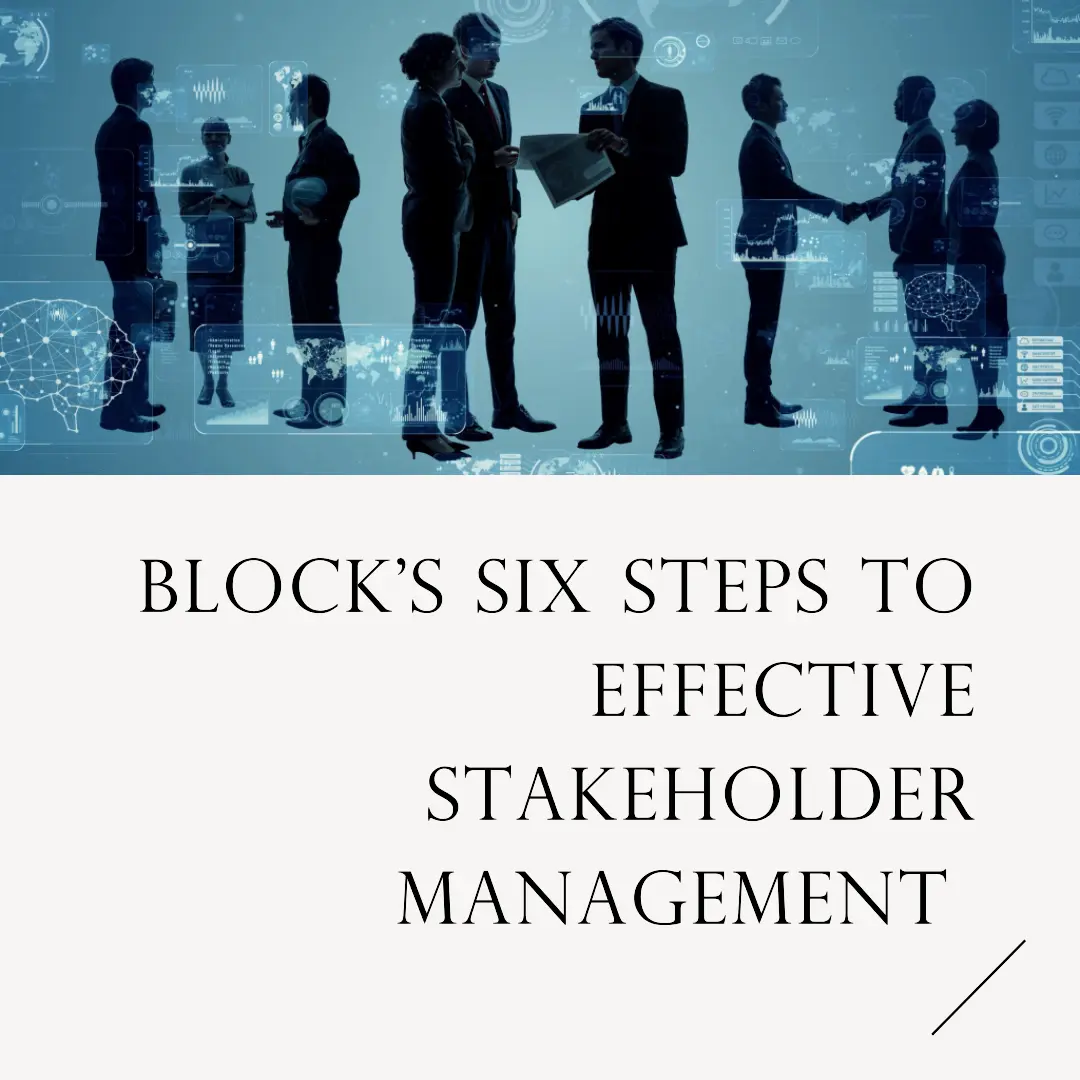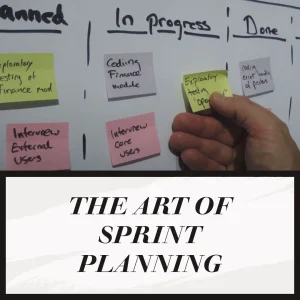To find out how Artificial Intelligence is changing the Project Management landscape, you may enjoy reading this article https://www.shaunstoltz.com/did-artificial-intelligence-just-change-everything-about-project-management/
I. Introduction
Hey there, project managers and aspiring leaders! Have you ever found yourself struggling to manage the diverse expectations and needs of the various stakeholders involved in your projects? Trust me, you’re not alone! Stakeholder management is a crucial aspect of any project, and it can make or break its success. That’s why I’m excited to share with you a game-changing approach that has helped me immensely in my own project management journey: Block’s six-step approach to stakeholder management.
But first, let’s take a moment to appreciate the importance of stakeholder management. In today’s interconnected world, projects often involve a wide range of stakeholders, from team members and clients to suppliers and regulators. Each stakeholder has their own set of expectations, interests, and concerns. Effectively managing these various relationships is key to ensuring project success, as it helps to align everyone’s goals, prevent conflicts, and ultimately drive better project outcomes.
Now, let’s dive into the heart of the matter: Block’s six-step approach to stakeholder management. This approach is a comprehensive and structured method that will empower you to systematically identify, engage, and manage stakeholders throughout your project’s lifecycle. By following these six steps, you’ll be well on your way to fostering strong stakeholder relationships, addressing potential issues proactively, and ultimately delivering a successful project that meets the needs and expectations of everyone involved.
In the coming sections, we’ll explore each of the six steps in detail, so you can confidently apply them to your next project. Let’s get started on this exciting journey together!
II. Step 1: Identify Stakeholders
Alright, so let’s kick off our exploration of Block’s six-step approach by diving into the first step: identifying your stakeholders. You might be thinking, “That sounds simple enough,” but trust me, this step is often overlooked or underestimated, and can lead to some major headaches later on in your project.
A. Definition of stakeholders
First, let’s clarify what we mean by stakeholders. In the context of project management, stakeholders are individuals, groups, or organizations that have a direct or indirect interest in your project. They can be internal, like your project team members, or external, like clients, suppliers, and regulators. Essentially, anyone who can affect or be affected by your project is a stakeholder.
B. Techniques to identify stakeholders
Now that we’re clear on who stakeholders are, let’s look at some tried-and-tested techniques for identifying them:
- Brainstorming: Gather your project team and brainstorm all the potential stakeholders you can think of. Remember, it’s better to be over-inclusive at this stage than to leave someone important out.
- Review project documents: Go through your project charter, scope statement, and other documents to identify stakeholders that may be mentioned there.
- Consult organizational charts: Analyze your organization’s structure and any partner organizations to identify key personnel and departments involved in your project.
- Seek advice from experienced colleagues: Reach out to colleagues who have managed similar projects in the past and ask for their insights on potential stakeholders.
C. Importance of early stakeholder identification
You might be wondering, “Why is it so important to identify stakeholders early on?” Great question! Early stakeholder identification helps you to:
- Understand and address stakeholder needs and expectations from the start, leading to better project outcomes.
- Engage stakeholders in the decision-making process, fostering a sense of ownership and commitment to the project.
- Identify potential risks and challenges, allowing you to proactively address them and avoid unpleasant surprises later on.
In the next section, we’ll delve into Step 2 of Block’s six-step approach, which involves analyzing stakeholder needs and interests. Trust me, this step is where things start to get really interesting! Stay tuned, and let’s continue this journey together.
III. Step 2: Analyze Stakeholder Needs and Interests
Now that you’ve identified your project’s stakeholders, it’s time to dive into the nitty-gritty: understanding their needs and interests. This step is essential for building a solid foundation for effective stakeholder engagement and management. So, let’s get down to business!
A. Understanding stakeholder expectations
Stakeholder expectations are the key drivers behind their involvement in your project. To effectively manage your stakeholders, you need to have a deep understanding of what they want and need from your project. This involves asking questions like:
- What are their main goals and priorities?
- How do they define project success?
- What potential concerns or challenges might they have?
B. Assessing stakeholder influence and importance
Next, it’s crucial to assess the influence and importance of each stakeholder. This helps you prioritize your stakeholder management efforts, ensuring that you’re focusing your energy and resources on the most critical relationships. To assess influence and importance, consider factors such as:
- The stakeholder’s level of authority within their organization.
- Their ability to impact project outcomes, either positively or negatively.
- The extent to which they can influence other stakeholders.
C. Creating a stakeholder matrix
Once you’ve gathered all this information, it’s time to organize it in a clear and actionable way. This is where the stakeholder matrix comes in handy. A stakeholder matrix is a visual tool that helps you map out your stakeholders based on their influence and importance. You can create a simple grid with two axes, one for influence and one for importance, and then plot each stakeholder on the grid.
By creating a stakeholder matrix, you’ll be able to quickly identify which stakeholders require the most attention and tailor your engagement strategies accordingly. This is a powerful tool that will help you optimize your stakeholder management efforts.
In our next section, we’ll explore Step 3 of Block’s six-step approach: developing a stakeholder engagement strategy. We’ll discuss setting objectives, choosing engagement methods, and crafting a communication plan that keeps your stakeholders informed and engaged. So, buckle up and get ready for more stakeholder management awesomeness!
IV. Step 3: Develop a Stakeholder Engagement Strategy
You’ve made it to Step 3 of Block’s six-step approach – give yourself a pat on the back! By now, you’ve identified your stakeholders, analyzed their needs and interests, and created a stakeholder matrix. It’s time to put all that information to work by developing a tailored stakeholder engagement strategy. Let’s dive in!
A. Setting objectives for stakeholder engagement
Before you start crafting your engagement strategy, it’s essential to set clear objectives. What do you want to achieve through your stakeholder engagement efforts? Common objectives might include:
- Building trust and rapport with stakeholders.
- Ensuring stakeholders understand the project’s goals and benefits.
- Addressing concerns and managing expectations.
- Gathering valuable input to inform project decisions.
B. Selecting appropriate engagement methods
Now that you’ve got your objectives in place, it’s time to choose the best engagement methods for each stakeholder. This is where your stakeholder matrix comes in handy. Based on the influence and importance of each stakeholder, you can select engagement methods that best align with their needs and expectations. Some examples include:
- High influence, high importance: Regular face-to-face meetings, personalized updates, and direct involvement in decision-making.
- High influence, low importance: Periodic email updates and occasional one-on-one check-ins.
- Low influence, high importance: Group meetings, workshops, or webinars to address concerns and gather input.
- Low influence, low importance: General email updates or newsletters to keep them informed about the project’s progress.
C. Developing a stakeholder communication plan
The final piece of the puzzle is creating a communication plan that outlines how, when, and with whom you’ll communicate throughout your project. A solid communication plan will help ensure that you’re consistently engaging your stakeholders in a meaningful and effective way. Key elements to include in your plan are:
- Stakeholder contact information.
- Preferred communication channels for each stakeholder (e.g., email, phone, in-person).
- Frequency of communication.
- Key messages to convey and topics to address.
- Who on your team is responsible for engaging each stakeholder.
With a well-thought-out stakeholder engagement strategy in place, you’re now ready to dive into Step 4 of Block’s six-step approach: implementing your engagement strategy. In the next section, we’ll discuss how to execute your communication plan, adapt to changes in stakeholder needs, and monitor stakeholder satisfaction. Stay tuned for more insights and tips to help you master the art of stakeholder management!
V. Step 4: Implement the Engagement Strategy
Kudos to you for making it to Step 4 of Block’s six-step approach! So far, we’ve covered identifying stakeholders, analyzing their needs and interests, and developing an engagement strategy. Now, it’s time to roll up your sleeves and put that strategy into action. Let’s explore how to effectively implement your engagement strategy.
A. Executing the communication plan
You’ve crafted a detailed communication plan, and now it’s time to bring it to life. Consistent and timely communication is key to maintaining strong stakeholder relationships, so be sure to follow your plan closely. Some tips for successful communication include:
- Be proactive: Don’t wait for stakeholders to come to you with questions or concerns. Reach out to them regularly to keep them informed and engaged.
- Be transparent: Share both good news and bad news with stakeholders, as honesty and openness help build trust.
- Be responsive: Make sure to address stakeholder inquiries, concerns, or feedback in a timely and respectful manner.
B. Adapting to changes in stakeholder needs and expectations
As your project progresses, stakeholder needs and expectations may evolve. It’s crucial to remain flexible and adapt your engagement strategy accordingly. Some tips for staying adaptable include:
- Regularly reassess stakeholder needs and interests: Check in with stakeholders to ensure you’re still meeting their expectations and addressing their concerns.
- Update your stakeholder matrix and communication plan: As stakeholder influence and importance change, adjust your engagement methods and communication frequency to match.
- Be open to feedback: Encourage stakeholders to share their thoughts and opinions, and use their feedback to refine your engagement approach.
C. Monitoring stakeholder satisfaction
Lastly, it’s essential to continually monitor stakeholder satisfaction throughout your project. This will help you identify potential issues before they escalate and ensure that you’re maintaining strong relationships with your stakeholders. Some methods for monitoring stakeholder satisfaction include:
- Conducting regular check-ins or surveys to gauge stakeholder satisfaction levels.
- Tracking and analyzing stakeholder feedback to identify trends or areas of concern.
- Observing stakeholder engagement during meetings or workshops to assess their level of interest and commitment.
With your engagement strategy in full swing, you’re ready to tackle the next step in Block’s six-step approach: evaluating stakeholder feedback. In the upcoming section, we’ll discuss how to collect, analyze, and incorporate stakeholder feedback into your project decisions. So, stay tuned and keep up the fantastic work on your stakeholder management journey!
VI. Step 5: Evaluate Stakeholder Feedback
Congratulations on reaching Step 5 of Block’s six-step approach! By now, you’re well on your way to mastering stakeholder management. In this step, we’ll focus on a crucial aspect of the process: evaluating stakeholder feedback. Let’s dive in and discover how to make the most of the valuable insights your stakeholders have to offer.
A. Collecting stakeholder feedback
First and foremost, you’ll need to gather feedback from your stakeholders. This can be done through a variety of methods, such as:
- Direct conversations: Engage stakeholders in one-on-one conversations or group discussions to solicit their thoughts and opinions.
- Surveys or questionnaires: Use online tools or paper forms to collect structured feedback from stakeholders.
- Feedback boxes or email inboxes: Provide a dedicated channel for stakeholders to submit their feedback anonymously or directly.
B. Analyzing and prioritizing feedback
With feedback in hand, it’s time to analyze and prioritize the information you’ve collected. This process will help you identify key themes, trends, and areas of concern that need to be addressed. Here are some tips for effective feedback analysis:
- Categorize feedback: Group feedback into themes or topics to make it easier to identify patterns and areas of focus.
- Assess the importance of each issue: Determine the potential impact of each piece of feedback on your project and prioritize issues accordingly.
- Identify actionable steps: For each priority issue, develop a clear action plan to address the concern and improve your project outcomes.
C. Incorporating feedback into project decisions
Lastly, it’s essential to incorporate stakeholder feedback into your project decisions. This not only helps you address concerns and improve your project but also demonstrates your commitment to stakeholder engagement. To effectively incorporate feedback, consider the following:
- Share the feedback with your project team: Discuss the feedback and any resulting action plans with your team to ensure everyone is on the same page.
- Make necessary adjustments: Based on the feedback, revise your project plan, scope, or timeline as needed to address stakeholder concerns.
- Communicate your actions: Inform stakeholders of the changes you’ve made in response to their feedback and express your appreciation for their input.
With stakeholder feedback evaluated and integrated into your project, you’re now ready for the final step in Block’s six-step approach: monitoring and adjusting stakeholder management strategies. In the next section, we’ll discuss how to continuously improve your stakeholder management efforts for long-term success. Keep up the great work, and let’s bring this stakeholder management journey to a strong finish!
VII. Step 6: Monitor and Adjust Stakeholder Management Strategies
Wow, you’ve made it to the final step of Block’s six-step approach! You’re now equipped with a solid foundation in stakeholder management, and I couldn’t be more proud of your progress. In this final step, we’ll focus on the importance of monitoring and adjusting your stakeholder management strategies to ensure ongoing success. Let’s wrap up this journey on a high note!
A. The importance of ongoing monitoring
Stakeholder management is not a one-and-done activity. It’s a continuous process that requires ongoing monitoring and adjustment to keep your relationships strong and your project on track. By regularly monitoring your stakeholder management efforts, you can:
- Identify and address emerging issues before they escalate.
- Ensure that stakeholder needs and expectations are continuously met.
- Adapt to changes in the project environment or stakeholder landscape.
B. Key indicators of stakeholder management success
To effectively monitor your stakeholder management strategies, it’s essential to track key indicators of success. These might include:
- Stakeholder satisfaction levels: Regularly gauge stakeholder satisfaction through check-ins, surveys, or other feedback methods.
- Project progress: Track how well your project is meeting stakeholder expectations and goals.
- Relationship quality: Assess the strength of your relationships with stakeholders based on factors such as trust, communication, and collaboration.
C. Adjusting your stakeholder management strategies
As you monitor your stakeholder management efforts, you may need to make adjustments to your strategies to maintain strong relationships and keep your project on track. Some tips for effectively adjusting your strategies include:
- Be proactive: Don’t wait for problems to arise before making changes. Regularly review your stakeholder management strategies and look for areas of improvement.
- Stay flexible: Be open to changing your engagement methods, communication frequency, or other aspects of your stakeholder management approach as needed.
- Learn from experience: Use the insights and lessons you’ve gained throughout the project to inform future stakeholder management efforts.
And there you have it – Block’s six-step approach to effective stakeholder management! By following these steps, you’re well on your way to fostering strong stakeholder relationships, delivering successful projects, and enhancing your reputation as a skilled project manager. Thank you for joining me on this journey, and I wish you the best of luck in all your future stakeholder management endeavors!
VIII. In Conclusion: Mastering Stakeholder Management with Block’s Six Steps
Well, my friend, you’ve made it to the end of this exciting journey through Block’s six-step approach to effective stakeholder management. I’m thrilled to have shared these insights with you, and I’m confident that you’re now well-prepared to tackle any stakeholder management challenge that comes your way. Before we part ways, let’s take a moment to recap the key takeaways from each step:
- Identify Stakeholders: Begin by creating a comprehensive list of all individuals and groups who have a stake in your project, including internal and external stakeholders.
- Analyze Stakeholder Needs and Interests: Develop a deep understanding of each stakeholder’s goals, priorities, and potential concerns, and assess their influence and importance.
- Develop a Stakeholder Engagement Strategy: Set clear objectives for stakeholder engagement, choose appropriate engagement methods, and craft a communication plan that keeps stakeholders informed and engaged.
- Implement the Engagement Strategy: Execute your communication plan, adapt to changes in stakeholder needs, and monitor stakeholder satisfaction throughout the project.
- Evaluate Stakeholder Feedback: Collect, analyze, and prioritize stakeholder feedback, and incorporate it into your project decisions.
- Monitor and Adjust Stakeholder Management Strategies: Continuously monitor your stakeholder management efforts, track key indicators of success, and make necessary adjustments to maintain strong relationships and achieve project success.
As you embark on your next project, remember that effective stakeholder management is an ongoing process that requires adaptability, open communication, and a genuine commitment to engaging with your stakeholders. By following Block’s six-step approach and incorporating the tips and strategies we’ve discussed, you’re well-equipped to build strong stakeholder relationships and deliver exceptional project results.
Thank you once again for joining me on this stakeholder management adventure! I wish you all the best in your future projects, and I’m confident that you’ll continue to excel in your stakeholder management efforts. Remember, you’ve got this!
Find out more about Shaun Stoltz https://www.shaunstoltz.com/about/
This post was written by an AI and reviewed/edited by a human.



